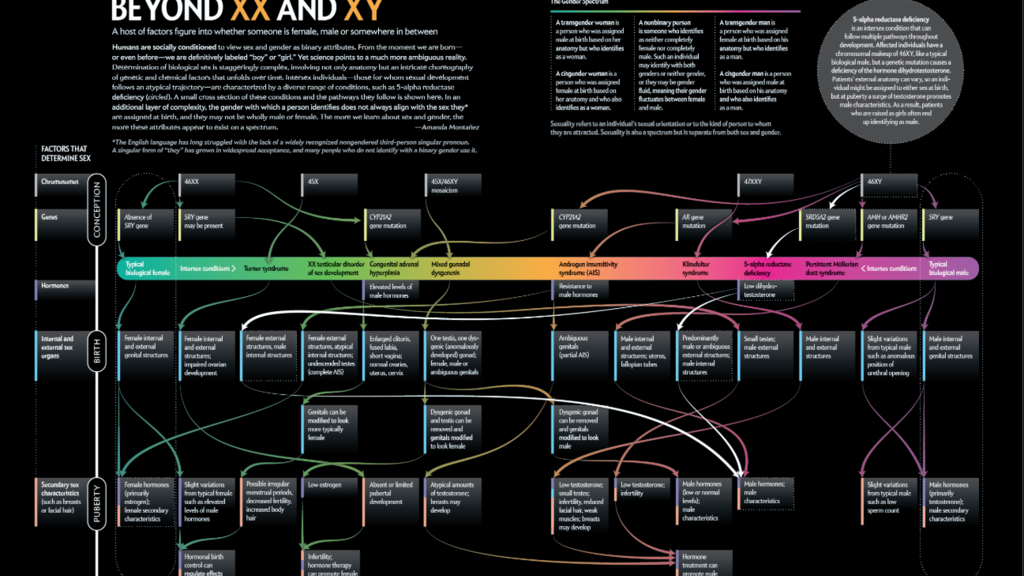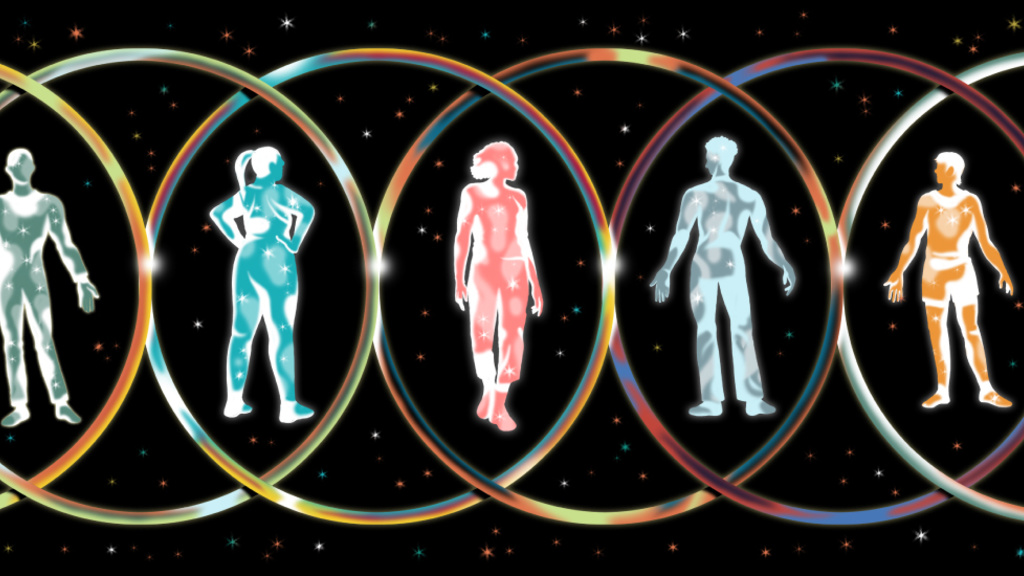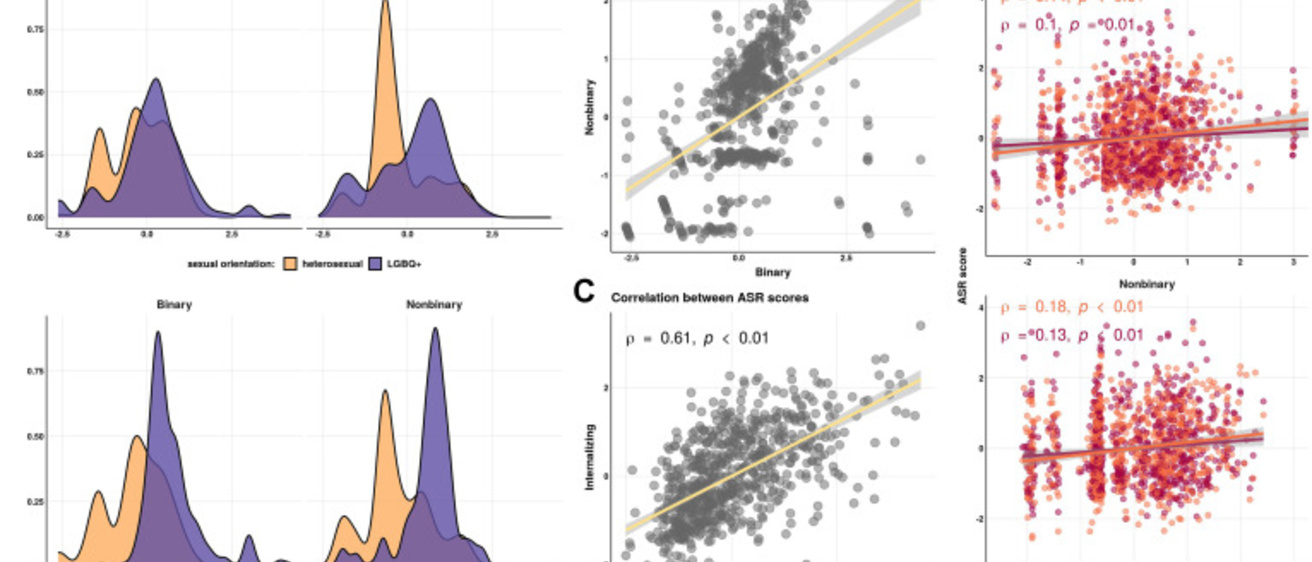Our goal is to better understand molecular and genetic interplay between sex, gender, and neurodevelopment.
Why This Research?
Biological sex has a strong relationship with neurodevelopmental and psychiatric conditions. For example, more men have autism than women (4:1) and more women have anorexia than men (8:1).1-2
Recent scientific advances have revealed this relationship isn't as simple as “men are more autistic because they have XY chromosomes” and “women have more eating disorders because they have XX chromosomes.” In fact, many factors related to sex, including sex hormones present in males and females, are involved.3
Gender adds another layer to our investigations. Gender is defined by social and cultural norms related to being a “man” or a “woman,” and can include identities beyond those two categories. Previous research has shown gender identity can be related to psychiatric conditions. For example, autism is more common in transgender or nonbinary individuals9-14.
Given the complexities described above, our research uses a continuous (rather than binary) approach to sex and gender to provide biological insights into psychiatric and neurodevelopmental conditions, and more generally into how the brain develops.

Visualizing Sex as a Spectrum
Scientific American has put together a thorough diagram of how sex determination can be visualized as a continuous spectrum, rather than the binary view of XX female and XY male.



Community Involvement: Considering All Perspectives
We are aware that gender diversity is a sensitive and, at times, heated topic in the current social and political climate. In an effort to respect this sensitivity, we have integrated community involvement into our research.
While we have prioritized the voices of those most likely to be affected by our findings (such as LGBTQ individuals and those with autism spectrum disorder [ASD]), we are interested in the perspectives of all people, regardless of identity or background.
We have already conducted a survey assessing how individuals from various backgrounds (LGBTQ and non-LGBTQ) perceive genetic and mental health research about sex and gender. Our results showed that attitudes towards this research was driven by a variety of factors, including perceptions of science research broadly, tolerance towards the LGBTQ community, and personal identities.
From the survey, we formed a community advisory council (CAC) composed of members from the LGBTQ and ASD communities. This council functions to review all results before publication, so we can develop messaging that is scientifically accurate, but also reduces risks and misinterpretation. Additionally, our research team and other collaborators include scientists who are members of the LGBTQ community.
Most recently, we consulted with a panel of both gender diverse and cisgender individuals to revise a questionnaire related to gender identity (not yet published).
While our first priority is ensuring that the voices of our LGBTQ partners are heard and the risks are minimized, we want to emphasize that as scientists we have no agenda. We form hypotheses based on current knowledge, collect data, and then analyze that data to support or refute our hypotheses.
Our Findings
Given the impact of sex and gender on the presentation of neuropsychiatric conditions, our past and present research aims to clarify the genetic intersection between sex, gender identity, and mental health.
We discovered no significant association between neuropsychiatric polygenic risk and gender diversity measured through the Gender Self-Report for a group of independent adults with autism. These results suggests that there is not a strong genetic overlap between the genetic variants leading to the development of mental health conditions and the genetic variants leading to the development of gender diversity.

Gender Self-Report: First-of-Its-Kind
The Gender Self-Report (GSR) was the first means of deeply capturing an individual's internal experiences of gender and gender diversity. "Prior tools didn't really capture all of the meaningful variation that exists. The GSR instead describes people’s gender using continuous values along several different dimensions. Wherever they exist in that space kind of has a slightly different meaning about their gender identity," says Jake Michaelson, quoted in this story.
Current Projects
We have recently created a rich and intentionally sculpted survey that captures a wide expanse of human experiences, including mental health traits, medical histories, and adverse life events (covering general, gender-related, LGBTQ-specific, and autism-specific stressors).
We are pairing this survey with a newly revised version of the Gender Self-Report, which we are also in the works of validating through a diverse gender, racial, geographical, and political sample.
All questions will be disseminated to 5,000-10,000 individuals with a personal or family history of autism through Spark Research Match.
Our main aim is to explore how adverse life experiences and stressors can affect mental health, with genetics as a potential mediator of those effects.
Frequently Asked Questions
What's the difference between 'sex' and 'gender' in your research?
It's simple - we use 'sex' to refer to the biological categories of male and female, determined by DNA and physical characteristics. 'Gender' refers to behavior and personality traits (including inner feelings) that typically align with being a man or woman. For most people (about 99%), sex and gender line up naturally, but for some people they don't. Our research acknowledges this reality because good medicine doesn't ignore any American who needs care, no matter how rare their situation might be.
Are sex and gender biological? I can hear one of my college professors saying “gender is a social construct."
Obviously sex is biological because it depends on sex chromosomes (X and Y) as well as how the body responds to its own natural hormones. Gender is the collection of behaviors and personality characteristics that are typical of each sex. We know from previous research that behavior and personality have strong genetic influences, so it makes sense that gender (how behavior and personality relate to sex), and how well you “fit in” is also under genetic influence. So yes, gender can be understood as a social construct – but it also exists in relation to genetic and biological underpinnings.
I feel like sex and gender are the same thing.
That’s not really a question, but your feeling is onto something. For the continuation of our species, there is a strong pull to align our sex with our gender (the sex-typical behaviors and personality traits). Geneticists talk about “selective pressure” as a force that keeps genetic changes in check, and that is at play here. If the human genome changed too quickly and in a way that made most humans completely uninterested in reproducing, those same changes would disappear.
There are only two genders.
Answer forthcoming.
Isn’t all this “gender diversity” stuff just a new fad? Why does it seem like nowadays there are so many people saying they’re trans or nonbinary? It didn’t used to be like this.
Answer forthcoming.
Additional Resources
Key Terms Defined
Throughout our research on sex and gender, we use various terms, many which can be (mis)interpreted differently outside of a scientific context. To provide clarity on key terms, we have listed their definitions below.
| neurodevelopment | the continuous process of the formation and maturation of the brain from fetal development through infancy and childhood, puberty and adolescence, and into adulthood |
| sex | a categorical descriptor based on the generalized reproductive role within a species. For humans, this is inferred at birth from observation of genitalia. While most newborns can be clearly assigned as male or female, some cases (0.1-1.5%) are ambiguous and may be reported as intersex |
| sex characteristics | indicators of sex, typically divided into primary and secondary categories. These are genetic, biological, physiological, morphological, or behavioral features that are associated with typical male or female development |
| primary sex characteristics | indicators of sex that are observable at birth, such as genitalia or configuration of sex chromosomes (i.e., karyotype - for example, XX female or XY male, though there are additional possibilities) |
| secondary sex characteristics | indicators of sex that typically emerge after birth, usually during puberty, and usually with a greater spectrum of variability than primary sex characteristics have. These include changes in patterns of body hair growth, breast and muscle development, distribution of body fat, voice development, sexual attraction, etc. |
| sexual orientation | indicators of sex that typically emerge after birth, usually during puberty, and usually with a greater spectrum of variability than primary sex characteristics have. These include changes in patterns of body hair growth, breast and muscle development, distribution of body fat, voice development, sexual attraction, etc. |
| gender | the behavioral norms for each sex that emerge at the population level, driven by a combination of biological, social, and cultural influences |
| gender identity | the relation of an individual to gender norms that is most consistent with that individual's feelings, perspectives, and behaviors
|
Further definitions of LGBTQ+ related terms can be found here:
Recommended Reading and Cited Literature
1 Sex differences in autism spectrum disorders: A review
This article provides a summary of theories and research into the male bias of autism.
2 Genes and pathways regulated by androgens in human neural cells, potential candidates for the male excess in autism spectrum disorder
Researchers analyzed gene expression differences from neural cells treated with androgens like testosterone, and they found differential expression in some genes implicated in autism. For a summary of this paper, click here.
3 Sex differences in the developing brain as a source of inherent risk
This is a review article of sex differences in neurodevelopment.
4 Neurobiology of gender identity and sexual orientation
This article is an organized review of the neurobiology of gender identity and sexual orientation. It discusses the influence of hormones in gender identity and sexual orientation, which ties in well with our hypothesis that related hormonal variation correlate with both gender identity/sexual orientation and autism.
5 The biological contributions to gender identity and gender diversity: bringing data to the table
Research in gender identity has mostly been focused on single genes; however, a recent group was established to have a big data, genomics approach to gender identity. This article provides a summary of genetic research and heritability studies of gender identity.
6 Sexual orientation, controversy, and science
This article provides an expansive summary of research in sexual orientation and would be a great place to start if interested in the subject.
7 Deep neural networks are more accurate than humans at detecting sexual orientation from facial images
Researchers developed a deep neural network using facial images from dating sites to predict sexual orientation, which is somewhat similar to our facial masculinity tool that predicts autism risk. For a summary of this paper, click here.
8 Large genome-wide analysis of sexual orientation identifies for the first time variants associated with non-heterosexual behavior and reveals overlap with heterosexual reproductive traits
A presentation at the American Society of Human Genetics showed the results from a genome-wide association study of 493,001 individuals and found 4 SNPs significantly associated with non-heterosexuality. You can check out the abstract of the presentation and a review article by Science News.
9 Jacobs, L. A., Rachlin, K., Erickson-Schroth, L. & Janssen, A. Gender Dysphoria and Co-Occurring Autism Spectrum Disorders: Review, Case Examples, and Treatment Considerations. LGBT health, 1, 277-282, doi:10.1089/lgbt.2013.0045 (2014).
10 Vermaat, L. E. W. et al. Self-Reported Autism Spectrum Disorder Symptoms Among Adults Referred to a Gender Identity Clinic. LGBT health, doi:10.1089/lgbt.2017.0178 (2018).
11 van der Miesen, A. I. R., Hurley, H., Bal, A. M. & de Vries, A. L. C. Prevalence of the Wish to be of the Opposite Gender in Adolescents and Adults with Autism Spectrum Disorder. Archives of sexual behavior, doi:10.1007/s10508-018-1218-3 (2018).
12 Heylens, G. et al. The Co-occurrence of Gender Dysphoria and Autism Spectrum Disorder in Adults: An Analysis of Cross-Sectional and Clinical Chart Data. Journal of autism and developmental disorders, 48, 2217-2223, doi:10.1007/s10803-018-3480-6 (2018).
13 van der Miesen, A. I. R., de Vries, A. L. C., Steensma, T. D. & Hartman, C. A. Autistic Symptoms in Children and Adolescents with Gender Dysphoria. Journal of autism and developmental disorders, 48, 1537-1548, doi:10.1007/s10803-017-3417-5 (2018).
14 George, R. & Stokes, M. A. Gender identity and sexual orientation in autism spectrum disorder. Autism: The international journal of research and practice, 1362361317714587, doi:10.1177/1362361317714587 (2017).
15 George, R. & Stokes, M. A. Sexual Orientation in Autism Spectrum Disorder. Autism research: Official journal of the International Society for Autism Research, 11, 133-141, doi:10.1002/aur.1892 (2018).
16 George, R. & Stokes, M. A. A Quantitative Analysis of Mental Health Among Sexual and Gender Minority Groups in ASD. Journal of autism and developmental disorders, 48, 2052-2063, doi: 10.1007/s10803-018-3469-1 (2018).
17 Varun Warrier, Richard A.I. Bethlehem, Daniel Geschwind, Simon Baron-Cohen. Genetic overlap between educational attainment, schizophrenia and autism. bioRxiv 093575; doi: 10.1101/093575
18 Power, R. A., Steinberg, S., Bjornsdottir, G., Rietveld, C. A., Abdellaoui, A., Nivard, M. M., … Stefansson, K. (2015). Polygenic risk scores for schizophrenia and bipolar disorder predict creativity. Nature Neuroscience, 18, 953. doi: 10.1038/nn.4040
Additional Questions?
If you have any more questions, please don't hesitate to contact our research team at michaelson-lab@uiowa.edu or at 319.335.8882.

